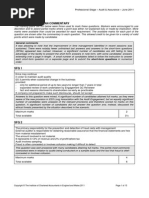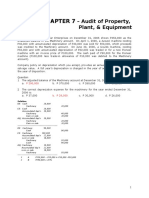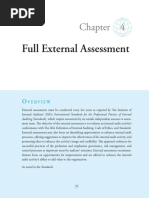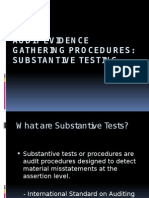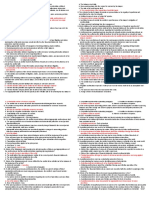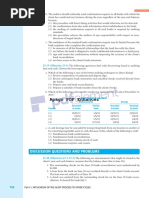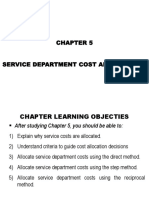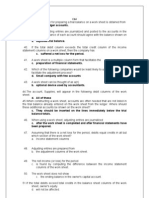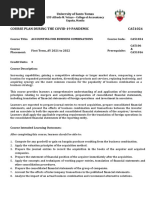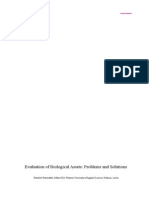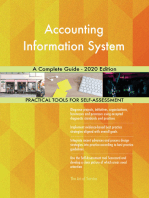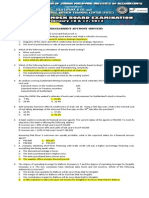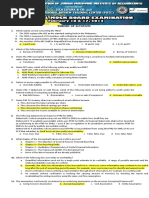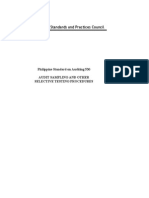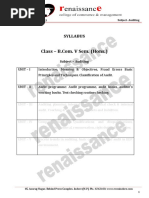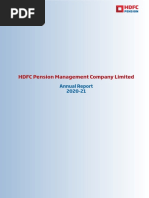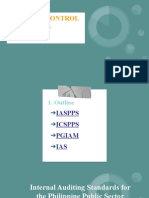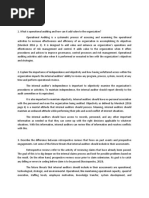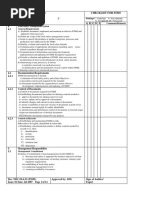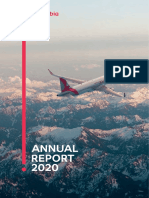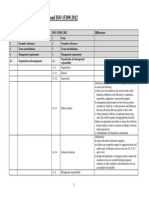AT ch16
AT ch16
Uploaded by
xxxxxxxxxCopyright:
Available Formats
AT ch16
AT ch16
Uploaded by
xxxxxxxxxOriginal Description:
Copyright
Available Formats
Share this document
Did you find this document useful?
Is this content inappropriate?
Copyright:
Available Formats
AT ch16
AT ch16
Uploaded by
xxxxxxxxxCopyright:
Available Formats
Operational and Governmental Compliance Auditing
MULTIPLE CHOICE:
1.
In a broad sense, society benefits from internal auditing
because the internal auditor
a.
Encourages corporate compliance with standards of
public policy.
b.
Promotes the efficient and effective use of resources.
c.
Evaluates financial data against professional
standards.
d.
Ensures that operations respond to the demands of the
marketplace.
ANSWER:
2.
Which of the following factors are essential to an
effective internal auditing organization?
I.
II.
III.
IV.
Operating responsibility
Organizational status
Objectivity
Authority over operations
a.
b.
c.
d.
I and II.
II and III.
III and IV.
I and IV.
ANSWER:
3.
The primary difference between operational auditing and
financial auditing is that in operational auditing
a.
The auditor is not concerned with whether the audited
activity is generating information in compliance with
financial accounting standards.
b.
The auditor is seeking to help management use
resources in the most effective manner possible.
c.
The auditor starts with the financial statements of an
activity being audited and works backward to the basic
processes involved in producing them.
d.
The auditor can use analytical skills and tools that
are not necessary in financial auditing.
ANSWER:
270
Chapter 16 Operational and Governmental Compliance Auditing
4.
The internal audit staff has been asked to conduct an audit
of the purchasing department. Top management feels that
there have been some production bottlenecks recently
because of out-of-stock situations. What is the primary
objective of the auditors in this assignment?
a.
b.
c.
d.
ANSWER:
5.
To appraise the economy with which resources are
employed.
To review the reliability and integrity of financial
and operating information.
To review the means of safeguarding assets and
verifying the existence of such assets.
To ascertain whether results are consistent with
established objectives and whether operations are
being carried out as planned.
D
Which of the following would be the most appropriate role
for the internal auditor in the cash budgeting process?
a.
b.
c.
d.
ANSWER:
6.
Reviewing budget policies and the design and
functioning of the budget process.
Working with the controller to prepare the budget.
Approving the budget before its implementation.
Analyzing monthly budget reports.
A
An internal auditor is performing an audit of the receiving
department to determine if only authorized purchases are
being accepted. Which of the following documents should
the auditor examine?
a.
b.
c.
d.
A bill of lading.
A blind (no quantities shown) copy of the purchase
order received directly from the purchasing
department.
An invoice.
A note documenting a telephone conversation with a
purchasing agent.
ANSWER:
7.
271
An auditor is attempting to determine whether or not
inventory is excessive. The inventory turnover rate was
4.7 this year as compared to 6.0 the prior year. The
272
Chapter 16 Operational and Governmental Compliance Auditing
average rate for the industry over the past three years was
6.2. From these facts, the auditor should conclude
a.
b.
c.
d.
ANSWER:
8.
b.
c.
d.
ANSWER:
Vouch payments made on the investment to the
controllers approval.
Review minutes of board of directors meetings for
investment approval.
Compliance test the functioning of the internal
controls over expenditures.
Confirm details of the purchase with the vendor.
B
Which of the following is not usually a part of the
preliminary survey phase of an audit?
a.
b.
c.
d.
ANSWER:
10.
Which of the following would be the most appropriate test
to determine if a major investment in a fixed asset was
properly authorized?
a.
9.
An inventory turnover rate this much lower than
normal suggests the possibility of excess inventory.
There is definitely an excess inventory problem
because the turnover rate is 1.5 times less than the
industry average.
The turnover rate differences are immaterial and thus
do not indicate a problem.
The possibility of excess inventory is not apparent
from these figures.
Touring operations.
Conducting audit inquiries.
Performing analytical review.
Developing the audit program.
D
An auditor decides to test the effectiveness and efficiency
of the short-term strategy being employed to market product
X. Which of the following would be the most appropriate
audit procedure?
a.
Discuss the effectiveness and the strategy with the
director of marketing.
Chapter 16 Operational and Governmental Compliance Auditing
b.
c.
d.
ANSWER:
11.
b.
c.
d.
ANSWER:
Determine the dates of unpaid accounts payable
invoices.
Compare dates of selected purchase orders with those
of purchase requisitions.
Select a block of used purchase order numbers and
account for all numbers in the block.
Discuss processing procedures with operating personnel
and observe actual processing of purchases.
B
In an audit of the transportation function, which of the
following tests is most appropriate to determine if there
is favoritism to individual carriers?
a.
b.
c.
d.
ANSWER:
13.
Discuss the effectiveness of the strategy with sales
supervisors and individual salespersons.
Compare sales of product X prior to and after
implementation of the short-term marketing strategy.
Evaluate performance goals incorporated into the
short-term strategy, and whether those goals are being
met.
Which of the following would be the most appropriate test
to determine whether purchase orders are being processed on
a timely basis?
a.
12.
273
Investigate selected demurrage charges to determine if
they were appropriate.
Determine if the selection of carriers is reviewed and
approved by a higher-ranking member of the traffic
department.
Determine whether freight bills have received a postaudit by the transportation department or an outside
specialized freight auditor.
Determine that the amount of freight billed to the
customer on the sales invoice is equal to the amount
actually charged your company by the carrier.
B
In the performance of an audit, audit risk is best defined
as the risk that an internal auditor
274
Chapter 16 Operational and Governmental Compliance Auditing
a.
b.
c.
d.
ANSWER:
14.
The role of the internal auditor with respect to a
purchasing department audit is to
a.
b.
c.
d.
ANSWER:
15.
Might not select documents that are in error as part
of the examination.
May not be able to properly evaluate an organization
because of its poor internal accounting controls.
May unknowingly fail to recognize appropriately a
material error or weakness in an examined
organization.
May not have the expertise to adequately audit a
specific entity.
Evaluate the adequacy of purchasing policies and
procedures and determine the extent of compliance.
Review and appraise the adequacy of controls over the
creation of all types of company obligations.
Review and appraise the conditions by which notes
payable come into existence and the control exercised
over them.
Establish that the purchasing department is
independent of receiving, inspection, stores, and
accounts payable activities.
A
In examining whether or not an auditee is conforming with
the companys affirmative action policy, the internal
auditor has found that:
1)
2)
Five percent of the employees are from minority
groups.
No one from a minority group has been hired this year.
The most appropriate conclusion the internal auditor should
draw is
a.
b.
c.
d.
Insufficient evidence exists of compliance with the
affirmative action policy.
The auditee is violating the companys policy.
The companys policy is unauditable and hence
unenforceable.
The auditee is complying with the affirmative action
policy.
Chapter 16 Operational and Governmental Compliance Auditing
ANSWER:
16.
b.
c.
d.
ANSWER:
To provide a final quality control review of the
accuracy of findings and reasonableness of conclusions
included in the report.
To inform the board of directors and top management
concerning major problems encountered.
To give auditee managers an advance start on solving
the problems outlined in the report.
To provide the auditor an opportunity to sell
auditee management on the benefits of implementing
recommendations.
A
The primary audience for the written report issued by the
internal auditor at the completion of an audit should be
a.
b.
c.
d.
ANSWER:
18.
Which of the following is the most important purpose of a
closing conference?
a.
17.
275
The external auditors when they intend to rely on the
internal auditors work.
Managers outside the area of audit so as to inform
them of what is going on in other areas of the
organization.
The audit committee who needs to be kept informed on
the risks to which the organization is exposed.
The management inside or outside the audited area who
can take corrective action.
D
An internal auditor determines that actual procedures
differ from prescribed control procedures. The auditor
should
1.
2.
3.
4.
a.
Require operating personnel to conform to prescribed
procedures.
Document the discrepancies and make any appropriate
recommendations to management.
Expand all aspects of the audit to determine other
differences from prescribed procedures.
Modify the audit plan as warranted by the differences
noted.
1 and 3
276
Chapter 16 Operational and Governmental Compliance Auditing
b.
c.
d.
ANSWER:
19.
c.
d.
ANSWER:
What the auditor found, the status, or condition.
The effect that implementing a recommendation is
expected to achieve.
The standard of performance, or what should be.
The cause or reason why the reported condition
occurred.
C
Follow-up activities by the internal auditor may be
terminated, even though corrective action has not been
taken, when the
a.
b.
c.
d.
ANSWER:
21.
One of the elements of a standard audit finding is
criteria. Which of the following best describes this
element of an audit finding?
a.
b.
20.
2 and 3
1 and 4
2 and 4
Recommendations concern activities not included in the
scope of the original audit program.
Board of directors or management has assumed the risk
of not taking corrective action.
Auditor has not convinced operating personnel of the
soundness of the audit recommendations.
Auditor has no authority or responsibility to
prescribe or direct the corrective action.
B
An internal auditor is preparing a final audit report to
management. There is, however, disagreement between the
auditor and the auditee on one finding which details the
auditees violation of corporate purchasing policy. The
auditee believes the purchasing policy is open to
interpretation and that there was no violation. The
auditor believes that the policy is clearly stated and that
the auditees actions were a violation. In this
circumstance, the auditor should
a.
b.
Delete the finding from the audit report.
Present only those facts, which support the audit
finding and ignore those which detract from it.
Chapter 16 Operational and Governmental Compliance Auditing
c.
d.
ANSWER:
22.
Present both the auditors and auditees positions in
the report.
Not issue the audit report until the auditor and
auditee agree on all audit findings and
recommendations.
C
A governmental audit may extend beyond an examination
leading to the expression of an opinion on the fairness of
financial presentation to include
Program
results
Yes
Yes
No
Yes
a.
b.
c.
d.
ANSWER:
23.
277
Compliance
Yes
Yes
Yes
No
Economy &
efficiency
No
Yes
Yes
Yes
Chevez is auditing an entitys compliance with requirements
governing a major federal financial assistance program in
accordance with the Single Audit Act. Chevez detected
noncompliance with requirements that have a material
effect on that program. Chevez report on compliance
should express a(an)
a.
b.
c.
d.
ANSWER:
Unqualified opinion with a separate explanatory
paragraph.
Qualified opinion or an adverse opinion.
Adverse opinion or a disclaimer or opinion.
Limited assurance on the items tested.
B
24. A companys new president meets the director of internal
audit for the first time, and asks the director to briefly
describe his departments overall responsibility. The
director states that internal audits overall responsibility
is to:
a.
b.
Act as an independent appraisal function to review
operations as a service to management by measuring and
evaluating the effectiveness of controls.
Review the means of safeguarding assets and, as
appropriate, verify the existence of such assets.
278
Chapter 16 Operational and Governmental Compliance Auditing
c.
Ensure compliance with policies, plans, procedures,
laws, and regulations, which could have a significant
impact on operations and reports.
Review the reliability and integrity of financial and
operating information and the means used to identify,
measure, classify, and report such information.
d.
ANSWER:
25.
According to the Standards, the internal audit director
should ensure follow-up of prior audit findings and
recommendations:
a.
To determine if corrective action was taken and is
achieving the desired results.
Unless management rejected the recommendation in their
initial response.
Unless the audit schedule does not allow time for
follow-up.
Unless management has accepted the recommendation.
b.
c.
d.
ANSWER:
26.
Internal auditing has been a dynamic profession. Which of
the following best describes the scope of internal auditing
as it has developed to date?
a.
b.
c.
d.
ANSWER:
27.
Internal auditing involves appraising the economy and
efficiency with which resources are employed.
Internal auditing involves evaluating compliance with
policies, plans, procedures, laws, and regulations.
Internal auditing has evolved to verifying the
existence of assets and reviewing the means of
safeguarding assets.
Internal auditing has evolved to more of an
operational orientation from a strictly financial
orientation.
D
You have been selected to develop an internal auditing
department for your company. Your approach would most
likely be to hire:
a.
Internal auditors each of whom possesses all the
skills required to handle all audit assignments.
Chapter 16 Operational and Governmental Compliance Auditing
b.
c.
d.
ANSWER:
28.
b.
c.
d.
ANSWER:
State the auditors position because the report is
designed to provide the auditors independent view.
State the auditees position because management is
ultimately responsible for the activities reported.
State both positions and identify the reasons for the
disagreement.
State neither position. If the disagreement is
ultimately resolved, there will be no reason to report
the previous disagreement. If the disagreement is
never resolved, the disagreement should not be
reported, because there is no mechanism to resolve it.
C
A charter is being drafted for a newly formed internal
auditing department. Which of the following best describes
the appropriate organizational status that should be
incorporated into the charter?
a.
b.
c.
d.
ANSWER:
30.
Inexperienced personnel and train them the way the
company wants them trained
Degreed accountants since most audit work is
accounting related.
Internal auditors who collectively have the knowledge
and skills needed to complete all internal audit
assignments.
Which of the following is the most appropriate method of
reporting disagreement between the auditor and the auditee
concerning audit findings and recommendations?
a.
29.
279
The director of internal auditing should report to the
chief executive officer but have access to the board
of directors.
The director of internal auditing should be a member
of the audit committee of the board of directors.
The director of internal auditing should be a staff
officer reporting to the chief financial officer.
The director of internal auditing should report to an
administrative vice president.
A
A primary concern of an operational audit of the family
welfare department of a governmental unit would be
280
Chapter 16 Operational and Governmental Compliance Auditing
a.
b.
c.
d.
ANSWER:
31.
b.
c.
d.
ANSWER:
The director reports directly to an independent audit
committee of the board of directors.
The director of internal auditing is not assigned any
operational responsibilities.
A director of internal auditing may not be appointed
or approved without concurrence of the board of
directors.
The directors annual bonuses are based on dollar
recoveries or recommended future savings as a result
of audits.
D
The president wants to know whether the purchasing function
is properly meeting its charge to: purchase the right
material at the right time in the right quantities. Which
of the following types of audits addresses the presidents
request?
a.
b.
c.
d.
ANSWER:
33.
Which of the following could be an organization factor that
might adversely affect the ethical behavior of the director
of internal auditing?
a.
32.
Determining that proper measures of performance are
used.
Generating an adequate return on investment.
Adhering to Generally Accepted Accounting Principles.
Ensuring that persons with direct client contact have
at least a bachelors degree.
A financial audit of the purchasing department.
An operational audit of the purchasing department.
A compliance audit of the purchasing function.
A full-scope audit of the manufacturing operation.
B
Which of the following audit techniques would be most
persuasive in determining that significant inventory values
on the books of a comp[any being acquired are correctly
stated?
a.
Obtain a management representation letter stating that
inventory values are correctly stated.
Chapter 16 Operational and Governmental Compliance Auditing
b.
c.
d.
ANSWER:
34.
ANSWER:
Schedule a follow-up review.
Implement corrective action indicated by the findings.
Examine further the data supporting the findings.
Assemble new data to support the findings.
A
Recommendations in audit reports may, or may not,. Actually
be implemented. Which of the following best describes
internal auditings role in follow-up on audit
recommendations?
Internal auditing:
a.
b.
c.
d.
ANSWER:
36.
Flowchart the inventory and warehousing cycle and form
an opinion based on the quality of internal controls.
Conduct a physical inventory and bring in an
independent expert if necessary to value inventory
items.
Interview purchasing and materials control personnel
to ascertain the quality of internal controls over
inventory.
After an audit report with adverse findings has been
communicated to appropriate auditee personnel, proper
action is to:
a.
b.
c.
d.
35.
281
Has no role; follow-up is managements responsibility.
Should be charged with responsibility for implementing
audit recommendations.
Should follow up to ascertain that appropriate action
is taken on audit recommendations.
Should request that independent auditors follow up on
audit recommendations.
C
The purpose of governmental effectiveness or program
results auditing is to determine if the desired results
of a program are being achieved. The first step in
conducting such an audit should be to:
a.
b.
c.
Evaluate the system used to measure results.
Determine the time frame to be audited.
Collect quantifiable data on the programs success or
failure.
282
Chapter 16 Operational and Governmental Compliance Auditing
d.
ANSWER:
37.
b.
c.
d.
ANSWER:
Allow the auditee to participate in development of
recommendations for improvement.
Emphasize the personal responsibility of the auditee
management.
Document the adverse finding with a complete list of
all operational deficiencies.
Submit a draft copy of the final report to higherlevel management.
A
A major difference between operational auditing and
financial auditing is
a.
b.
c.
d.
ANSWER:
39.
An operational audit resulted in a finding regarding
efficiency of operations. Select the best approach to gain
the auditees cooperation in this situation.
a.
38.
Identify the legislative intent of the program being
audited.
Operational auditing focuses on activities rather than
financial statement assertions.
Operational auditing extends beyond the entity to
analysis of industry and economic data.
Unlike financial auditing, operational auditing does
not generally culminate in a formal audit report.
Operational auditing is narrower than financial
auditing in its breadth of coverage.
A
In conducting an operational audit, the following steps are
generally recommended:
A.
B.
C.
D.
E.
F.
G.
H.
Develop the audit program
Perform the audit
Identify audit objectives
Evaluate the findings and develop conclusions
and recommendations
Establish evaluation criteria
Report findings and recommendations
Conduct a preliminary survey of the activity
Appraise the efficiency and effectiveness of the
activity
Chapter 16 Operational and Governmental Compliance Auditing
283
The proper sequence for applying the above steps is:
a.
b.
c.
d.
ANSWER:
40.
c.
d.
ANSWER:
Assessing the goal setting process.
Determining the extent to which goals are being
achieved and the degree of coal congruence.
Assessing the financial stability of the unit.
Appraising the effectiveness of resource utilization
within the unit or activity.
C
The primary difference between an operational audit report
and an independent financial audit report is
a.
b.
c.
d.
ANSWER:
42.
A major part of an operational audit involves appraising
the efficiency and effectiveness of the activity or unit
being audited. Efficiency and effectiveness appraisal
include all but the following steps:
a.
b.
41.
D,H,B,F,E,G,A,C
C,E,G,A,H,B,D,F
E,C,A,G,D,H,B,F
C,E,G,A,B,H,D,F
The operational audit report makes no mention of
internal control.
The operational audit report is not constrained to a
single standard reporting format.
The operational audit report stresses consistency
among accounting periods.
Unlike the independent auditor, the internal auditor
generally does not discuss the audit findings and the
nature of the audit report with the auditee.
B
Which of the following is not a source of responsibility
for an independent auditor conducting a governmental
compliance audit?
a.
b.
Governmental auditing standards as set forth in the
General Accounting Offices yellow book.
Standards for the Professional Practice of Internal
Auditing.
284
Chapter 16 Operational and Governmental Compliance Auditing
c.
d.
ANSWER:
Generally Accepted Auditing Standards as promulgated
by the Auditing Standards Board of the AICPA.
Federal Single Audit Act of 1984 (as amended in 1996).
B
COMPLETION:
43.
Management auditing concentrates more on ____________ than
efficiency.
ANSWER:
44.
Efficiency is __________ oriented, whereas effectiveness is
__________ oriented.
ANSWER:
45.
EVALUATION CRITERIA
The __________ __________ consists of those procedures
necessary to satisfy the audit objectives and produce
sufficient and competent evidence to corroborate or refute
the auditors preliminary findings.
ANSWER:
48.
RISK-BASED
In conducting an operational audit, identification of
___________ __________ is necessary if the auditor is to
ultimately determine the cause of discovered
inefficiencies.
ANSWER:
47.
INPUT OUTPUT
Until recently, operational auditing performed recurring
efficiency and effectiveness audits on different functions
or units in a company. The emphasis has now begun to shift
away from recurring audits to focus more on managements
special problems. This latter approach is referred to as
________- __________ operational auditing.
ANSWER:
46.
EFFECTIVENESS
AUDIT PROGRAM
In drafting an operational audit report, the difference
between actual and expected conditions should be presented
as to _______ and _______.
ANSWER:
CAUSE EFFECT
Chapter 16 Operational and Governmental Compliance Auditing
49.
When auditing state and local governmental entities that
are recipients of federal financial assistance, auditors
must, in addition to generally accepted auditing standards,
comply with governmental auditing standards, as defined in
the GAOs _________ _________.
ANSWER:
50.
285
YELLOW BOOK
In addition to GAAS and yellow book standards, an auditee
that receives $300,000 or more in federal financial
assistance in a single fiscal year, must be audited in
accordance with the ________ ________ _______ __ ____.
ANSWER:
SINGLE AUDIT ACT OF 1984
MATCHING:
51.
Select the term that best fits the listed definition.
A. Circular A-133
B. Effectiveness
C. Efficiency
D. Evaluation criteria
E. Yellow book
F. Risk-based operational auditing
G. Percentage-of-coverage rule
H. Operational auditing
I. Management auditing
J. General Accounting Office
K. Foreign Corrupt Practices Act of 1977
L. Single Audit Act of 1984 (as amended in 1996)
M. Governmental compliance auditing
____1.
A subset of internal auditing that reviews an entitys
activities for efficiency and effectiveness.
____2.
A subset of operational auditing that attempts to
measure the effectiveness with which an organizational
unit is administered.
____3.
May be viewed as an input measure.
____4.
May be viewed as an output measure.
____5.
Requires companies to develop and implement internal
controls that permit preparation of financial
286
Chapter 16 Operational and Governmental Compliance Auditing
statements in accordance with GAAP and to maintain
accountability over assets.
____6.
An audit approach that focuses on managements special
problems and means for solving them.
____7.
Define the process or activity being audited.
____8.
Auditing that concentrates on testing and reporting on
conformity with laws and regulations relating to
recipients of federal financial assistance.
____9.
A GAO document that sets forth governmental auditing
standards.
____10.
A federal law that establishes audit requirements for
state and local governmental bodies and other not-forprofit entities receiving federal financial
assistance.
____11.
Requires that at least 50% of federal expenditures be
encompassed by the independent audit.
____12.
The document that interprets and explains the major
provisions of the Single Audit Act of 1984 (as amended
in 1996).
SOLUTION:
1.
2.
3.
4.
5.
6.
7.
8.
9.
10.
11.
12.
H
I
C
B
K
F
D
M
E
L
G
A
Chapter 16 Operational and Governmental Compliance Auditing
287
You might also like
- Audit and Assurance June 2011 Marks PlanDocument15 pagesAudit and Assurance June 2011 Marks Planjakariauzzal100% (1)
- Audit of ReceivablesDocument32 pagesAudit of Receivablesxxxxxxxxx96% (55)
- Audit of Cash and Cash EquivalentsDocument38 pagesAudit of Cash and Cash Equivalentsxxxxxxxxx86% (81)
- Module 9 - Substantive Proc - Class Q - 23 JulyDocument47 pagesModule 9 - Substantive Proc - Class Q - 23 JulyLindiweNo ratings yet
- Audit of Stockholders EquityDocument25 pagesAudit of Stockholders Equityxxxxxxxxx87% (39)
- CHAPTER 7 Caselette - Audit of PPEDocument34 pagesCHAPTER 7 Caselette - Audit of PPErochielanciola50% (6)
- Quality Assessment Manual Chapter 4Document14 pagesQuality Assessment Manual Chapter 4Allin John FranciscoNo ratings yet
- Audit of InventoryDocument32 pagesAudit of Inventoryxxxxxxxxx92% (48)
- ISO 45001 2018 UpdatedDocument44 pagesISO 45001 2018 UpdatedSagar Shah100% (4)
- Final Exam Review: 1. Identify Managers' Three Primary Responsibilities. A. Planning B. Directing C. ControllingDocument4 pagesFinal Exam Review: 1. Identify Managers' Three Primary Responsibilities. A. Planning B. Directing C. ControllingSandip AgarwalNo ratings yet
- Auditing Theory 250 QuestionsDocument39 pagesAuditing Theory 250 Questionsxxxxxxxxx75% (4)
- Relevant Costing CPARDocument13 pagesRelevant Costing CPARxxxxxxxxx100% (2)
- Practical Accounting 1 With AnswersDocument10 pagesPractical Accounting 1 With Answerslibraolrack50% (8)
- Taxation With AnswersDocument8 pagesTaxation With AnswersMarion Tamani Jr.50% (2)
- Audit of LiabilitiesDocument33 pagesAudit of Liabilitiesxxxxxxxxx96% (28)
- Taxation With AnswersDocument8 pagesTaxation With AnswersMarion Tamani Jr.50% (2)
- Correction of ErrorsDocument37 pagesCorrection of Errorsxxxxxxxxx76% (37)
- Chapter 1 - Audit: An OverviewDocument78 pagesChapter 1 - Audit: An OverviewMarnelli CatalanNo ratings yet
- First Preboard ExamsDocument4 pagesFirst Preboard ExamsRandy PaderesNo ratings yet
- 03 Receivables PDFDocument13 pages03 Receivables PDFReyn Saplad PeralesNo ratings yet
- Auditevidence Gathering Procedures: SubstantivetestingDocument9 pagesAuditevidence Gathering Procedures: Substantivetestingnica leeNo ratings yet
- CAS 520 Analytical ProceduresDocument8 pagesCAS 520 Analytical ProcedureszelcomeiaukNo ratings yet
- Mockboard (Mas)Document3 pagesMockboard (Mas)Nezhreen MaruhomNo ratings yet
- Chapter 21 Internal, Operational, and Compliance Auditing: True/False QuestionsDocument13 pagesChapter 21 Internal, Operational, and Compliance Auditing: True/False QuestionsRNo ratings yet
- Nfjpia Nmbe Far 2017 AnsDocument9 pagesNfjpia Nmbe Far 2017 AnsSamieeNo ratings yet
- Chapter 2-Audits of Financial Statements PDFDocument23 pagesChapter 2-Audits of Financial Statements PDFCaryll Joy BisnanNo ratings yet
- Other PSAs and PAPSsDocument7 pagesOther PSAs and PAPSsnikNo ratings yet
- Afar8721 8722 Npo PDFDocument3 pagesAfar8721 8722 Npo PDFSid TuazonNo ratings yet
- Correction of ErrorsDocument6 pagesCorrection of ErrorsJanjielyn MoralesNo ratings yet
- Seatwork 3-Liabilities 22Aug2019JMDocument3 pagesSeatwork 3-Liabilities 22Aug2019JMJoseph II MendozaNo ratings yet
- Gonzaga - Sec1 - Exercises On Internal Control FrameworkDocument2 pagesGonzaga - Sec1 - Exercises On Internal Control FrameworkSteph GonzagaNo ratings yet
- Sample Exam 2Document16 pagesSample Exam 2Zenni T XinNo ratings yet
- Auditing and Assurance - Concepts and Applications - Heading PDFDocument4 pagesAuditing and Assurance - Concepts and Applications - Heading PDFLuisitoNo ratings yet
- Toa - 2011Document7 pagesToa - 2011EugeneDumalagNo ratings yet
- ACCOUNTING 12-07 - Audit-Assurance-Ethics-and-GovernanceDocument11 pagesACCOUNTING 12-07 - Audit-Assurance-Ethics-and-GovernanceNico evansNo ratings yet
- At 04 Auditing in A Cis EnvironmentDocument15 pagesAt 04 Auditing in A Cis EnvironmentaceNo ratings yet
- Practice Examination in Auditing TheoryDocument28 pagesPractice Examination in Auditing TheoryGabriel PonceNo ratings yet
- V. Preliminary Engagement ActivitiesDocument8 pagesV. Preliminary Engagement ActivitiesKrizza Mae100% (1)
- CH 11 Question Book - Not ReconciliationDocument5 pagesCH 11 Question Book - Not Reconciliationahmed0% (1)
- Name: - Date: - Year &sec. - ScoreDocument9 pagesName: - Date: - Year &sec. - ScoreFordan AntolinoNo ratings yet
- Welcome To The Presentation of The: Group 4Document126 pagesWelcome To The Presentation of The: Group 4Ronald Jason RomeroNo ratings yet
- 20201st Sem Syllabus Auditing Assurance PrinciplesDocument10 pages20201st Sem Syllabus Auditing Assurance PrinciplesJamie Rose AragonesNo ratings yet
- Sol. Man. - Chapter 13 - Share Based Payments (Part 2) - 2021Document3 pagesSol. Man. - Chapter 13 - Share Based Payments (Part 2) - 2021Nikky Bless LeonarNo ratings yet
- Philippine Accounting Standard No. 1: Presentation of Financial StatementsDocument58 pagesPhilippine Accounting Standard No. 1: Presentation of Financial StatementsDark PrincessNo ratings yet
- PSBA - GAAS and System of Quality ControlDocument10 pagesPSBA - GAAS and System of Quality ControlephraimNo ratings yet
- Chapter 5 Service Department Cost AllocationsDocument48 pagesChapter 5 Service Department Cost AllocationsMulugeta GirmaNo ratings yet
- Chap 10 Transaction Cycle KEYDocument9 pagesChap 10 Transaction Cycle KEYLương Vân TrangNo ratings yet
- Auditing Finance and Accounting FunctionsDocument14 pagesAuditing Finance and Accounting FunctionsApril ManjaresNo ratings yet
- Steps in Audit Engagement CDocument5 pagesSteps in Audit Engagement CReland CastroNo ratings yet
- TOA Quizzer 1 - Intro To PFRSDocument6 pagesTOA Quizzer 1 - Intro To PFRSmarkNo ratings yet
- Accounting 3 NotesDocument7 pagesAccounting 3 NotesJudyNo ratings yet
- Accounitng Princples Ch4 TestbankDocument7 pagesAccounitng Princples Ch4 TestbankBayan Sharif100% (3)
- Auditing in Specialized IndustriesDocument3 pagesAuditing in Specialized IndustriesJeremae Ann CeriacoNo ratings yet
- Cash To Inventory Reviewer 1Document15 pagesCash To Inventory Reviewer 1Patricia Camille Austria100% (1)
- Chapter 06Document144 pagesChapter 06Shawn Lee100% (1)
- AP 2020 - Inventories 2Document9 pagesAP 2020 - Inventories 2Heinie Joy PauleNo ratings yet
- Course Plan - CA51024 - AY2021-2022Document10 pagesCourse Plan - CA51024 - AY2021-2022Jaimell LimNo ratings yet
- Evaluation of Biological Assets Problems and SolutionsDocument16 pagesEvaluation of Biological Assets Problems and Solutionsidhan0% (1)
- The Role of AuditorDocument7 pagesThe Role of AuditoradiscsiNo ratings yet
- Internal ControlDocument6 pagesInternal ControlAlissaNo ratings yet
- Audit in CIS Environment Quiz 3Document3 pagesAudit in CIS Environment Quiz 3ctcasipleNo ratings yet
- At Reviewer Part II - (May 2015 Batch)Document22 pagesAt Reviewer Part II - (May 2015 Batch)Jake BundokNo ratings yet
- AUDITINGDocument20 pagesAUDITINGAngelieNo ratings yet
- Solutions For Chapter 1 Auditing: Integral To The Economy: Review QuestionsDocument26 pagesSolutions For Chapter 1 Auditing: Integral To The Economy: Review QuestionsStefany Mie MosendeNo ratings yet
- AIS Chapter 3 Ethics 2Document7 pagesAIS Chapter 3 Ethics 2boa1315100% (1)
- Auditing S2 - Chapter 5Document11 pagesAuditing S2 - Chapter 5p aloaNo ratings yet
- Audit of InventoriesDocument2 pagesAudit of InventoriesWawex DavisNo ratings yet
- CFAS-MC Ques - Review of The Acctg. ProcessDocument5 pagesCFAS-MC Ques - Review of The Acctg. ProcessKristine Elaine RocoNo ratings yet
- Auditing Theory Review Notes (AT-3) Page 1 of 13: Industry ConditionsDocument13 pagesAuditing Theory Review Notes (AT-3) Page 1 of 13: Industry ConditionsJane Michelle EmanNo ratings yet
- PrE5 - Auditing in A CIS EnvironmentDocument14 pagesPrE5 - Auditing in A CIS EnvironmentGlynnis EscobarNo ratings yet
- 4-Auditing 2 - Chapter FourDocument8 pages4-Auditing 2 - Chapter Foursamuel debebeNo ratings yet
- Accounting Information System A Complete Guide - 2020 EditionFrom EverandAccounting Information System A Complete Guide - 2020 EditionRating: 1 out of 5 stars1/5 (1)
- Value Chain Management Capability A Complete Guide - 2020 EditionFrom EverandValue Chain Management Capability A Complete Guide - 2020 EditionNo ratings yet
- Business Law Preboard FinalDocument7 pagesBusiness Law Preboard Finalxxxxxxxxx100% (1)
- At AnswerKeyDocument9 pagesAt AnswerKeyRosalie E. BalhagNo ratings yet
- NFJPIA Mockboard 2011 Auditing TheoryDocument6 pagesNFJPIA Mockboard 2011 Auditing TheoryKathleen Ang100% (1)
- At AnswerKeyDocument9 pagesAt AnswerKeyRosalie E. BalhagNo ratings yet
- Cost of CapitalDocument10 pagesCost of CapitalCharmaine ChuNo ratings yet
- Financial Statement Analysis - CPARDocument13 pagesFinancial Statement Analysis - CPARxxxxxxxxx100% (2)
- Practical Accounting 2 With AnswersDocument11 pagesPractical Accounting 2 With Answerskidrauhl0767% (6)
- MAS With Answers PDFDocument13 pagesMAS With Answers PDF蔡嘉慧100% (1)
- Theory of Accounts Mockboard 2013 With AnswersDocument9 pagesTheory of Accounts Mockboard 2013 With AnswersxxxxxxxxxNo ratings yet
- Business Law Preboard FinalDocument7 pagesBusiness Law Preboard Finalxxxxxxxxx100% (1)
- Auditing Problems With AnswersDocument12 pagesAuditing Problems With Answersaerwinde79% (34)
- Business Law Preboard FinalDocument7 pagesBusiness Law Preboard Finalxxxxxxxxx100% (1)
- Financial Statement Analysis - CPARDocument13 pagesFinancial Statement Analysis - CPARxxxxxxxxx100% (2)
- Business Law Preboard FinalDocument7 pagesBusiness Law Preboard Finalxxxxxxxxx100% (1)
- Psa 530Document25 pagesPsa 530Rico Jon Hilario GarciaNo ratings yet
- Psa 710Document18 pagesPsa 710xxxxxxxxxNo ratings yet
- Alchemy 20audit 20case 20study Final 20version 3 PDFDocument10 pagesAlchemy 20audit 20case 20study Final 20version 3 PDFNatala WillzNo ratings yet
- Auditing NotesDocument9 pagesAuditing NotesShubham Khess100% (1)
- MacCharles Tamakloe Dissertation UGSMDocument466 pagesMacCharles Tamakloe Dissertation UGSMTamakloeNo ratings yet
- HDFC Pension Management Company Limited: Annual Report 2020-21Document33 pagesHDFC Pension Management Company Limited: Annual Report 2020-21Rupesh SinghNo ratings yet
- ProfileDocument60 pagesProfileA Kumar LegacyNo ratings yet
- Uoc Annual Report 2018Document112 pagesUoc Annual Report 2018GitanjaliNo ratings yet
- Raviteja Bodi: Mobile: 9441106105Document3 pagesRaviteja Bodi: Mobile: 9441106105b.ravitejaNo ratings yet
- Ejemplos Tortuga IatfDocument1 pageEjemplos Tortuga IatfAnonymous XzqXVMjNo ratings yet
- File Ficco Regulations 2004Document9 pagesFile Ficco Regulations 2004Daniel MarikiNo ratings yet
- Gbermic 3 Sec Code of Corporate GovernanceDocument10 pagesGbermic 3 Sec Code of Corporate Governancedraga pinasNo ratings yet
- Final Version MPA 626 Group 2 PresentationDocument231 pagesFinal Version MPA 626 Group 2 PresentationSherry Mae EsteleydesNo ratings yet
- Chapter 1 OpaudDocument5 pagesChapter 1 OpaudMelissa Kayla Maniulit0% (1)
- 0.checklist, GP3113 ISO 14001 2015 EvaluationDocument29 pages0.checklist, GP3113 ISO 14001 2015 EvaluationAshraf SeragNo ratings yet
- Operational Audit Presentation ADDocument23 pagesOperational Audit Presentation ADlittleglam100% (1)
- Checklist & Guideline ISO 22000Document14 pagesChecklist & Guideline ISO 22000Documentos Tecnicos67% (6)
- ReSA B42 AUD First PB Exam Questions Answers Solutions PDFDocument24 pagesReSA B42 AUD First PB Exam Questions Answers Solutions PDFNamnam KimNo ratings yet
- AA AnnualReport 2020 enDocument28 pagesAA AnnualReport 2020 enGhardaddou YasserNo ratings yet
- Comparison Iso 15189 - 2007-2012Document24 pagesComparison Iso 15189 - 2007-2012smallik3No ratings yet
- Moving Internal Audit Deeper Into The Digital AgeDocument20 pagesMoving Internal Audit Deeper Into The Digital AgeRizwan TariqNo ratings yet
- Suryo Pratolo: Good Corporate GovernanceDocument26 pagesSuryo Pratolo: Good Corporate Governancesriintan09gmail.com intan99No ratings yet
- PSDB Audit Committee CharterDocument3 pagesPSDB Audit Committee CharterjoachimjackNo ratings yet
- Auditing TheoryDocument10 pagesAuditing TheoryAnna Mae SanchezNo ratings yet
- Bylaws PrimaryDocument36 pagesBylaws PrimaryJannah Rochelle OretaNo ratings yet
- Risk Management Training CourseDocument6 pagesRisk Management Training CourseBrighton MasukuNo ratings yet
- 2011 AICPA Auditing QuestionsDocument66 pages2011 AICPA Auditing QuestionssheereencNo ratings yet
- PPA Notes Module 2Document22 pagesPPA Notes Module 2Community Institute of Management StudiesNo ratings yet
- Risk Management - Session 6 Practice Quiz - Attempt Review - OpenLearn - Open UniversityDocument5 pagesRisk Management - Session 6 Practice Quiz - Attempt Review - OpenLearn - Open UniversityKarolina gonzalezNo ratings yet
